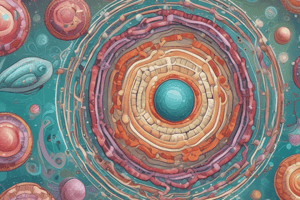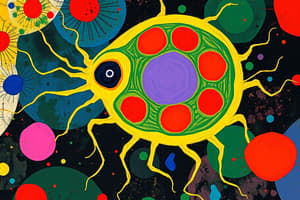Podcast
Questions and Answers
Which structure collects extra water from the cytoplasm and then expels it from the cell?
Which structure collects extra water from the cytoplasm and then expels it from the cell?
- Food vacuole
- Cilia
- Contractile vacuole (correct)
- Pseudopod
What is the characteristic feature of Zooflagellates that helps them move?
What is the characteristic feature of Zooflagellates that helps them move?
- Sporozoans
- Flagella (correct)
- Cilia
- Pseudopods
Which type of protists are non-motile and pass from one host to another, often through ticks, mosquitoes, or other animals to humans?
Which type of protists are non-motile and pass from one host to another, often through ticks, mosquitoes, or other animals to humans?
- Sporozoans (correct)
- Zooflagellates
- Ciliates
- Sarcodines
What is the role of symbiosis in the context of biology?
What is the role of symbiosis in the context of biology?
Which characteristic distinguishes plant-like protists (algae) from other groups of protists?
Which characteristic distinguishes plant-like protists (algae) from other groups of protists?
Which of the following is a general characteristic of protists?
Which of the following is a general characteristic of protists?
How are plant-like protists classified based on their nutrition?
How are plant-like protists classified based on their nutrition?
What is the primary method of reproduction in protists?
What is the primary method of reproduction in protists?
What are animal-like protists called?
What are animal-like protists called?
Which of the following diseases can be caused by protists?
Which of the following diseases can be caused by protists?
Protists with cilia, pseudopodia, or flagellum are all classified as animal-like protists.
Protists with cilia, pseudopodia, or flagellum are all classified as animal-like protists.
All protists lack cell walls.
All protists lack cell walls.
All protists are multicellular organisms.
All protists are multicellular organisms.
Protists that cause diseases such as Malaria and Dysentery are exclusively autotrophic.
Protists that cause diseases such as Malaria and Dysentery are exclusively autotrophic.
All protists found mainly in water are classified as plant-like protists.
All protists found mainly in water are classified as plant-like protists.
Sporozoans are primarily parasites and are capable of moving from one host to another.
Sporozoans are primarily parasites and are capable of moving from one host to another.
All algae are unicellular and unable to make their own food through photosynthesis.
All algae are unicellular and unable to make their own food through photosynthesis.
Ciliates use flagella for movement and feeding purposes.
Ciliates use flagella for movement and feeding purposes.
Zooflagellates are exclusively free swimming and do not have any parasitic members.
Zooflagellates are exclusively free swimming and do not have any parasitic members.
Plasmodium, the genus responsible for malaria, has a complex reproductive cycle involving both a sexual phase and an asexual phase inside two different organisms.
Plasmodium, the genus responsible for malaria, has a complex reproductive cycle involving both a sexual phase and an asexual phase inside two different organisms.




